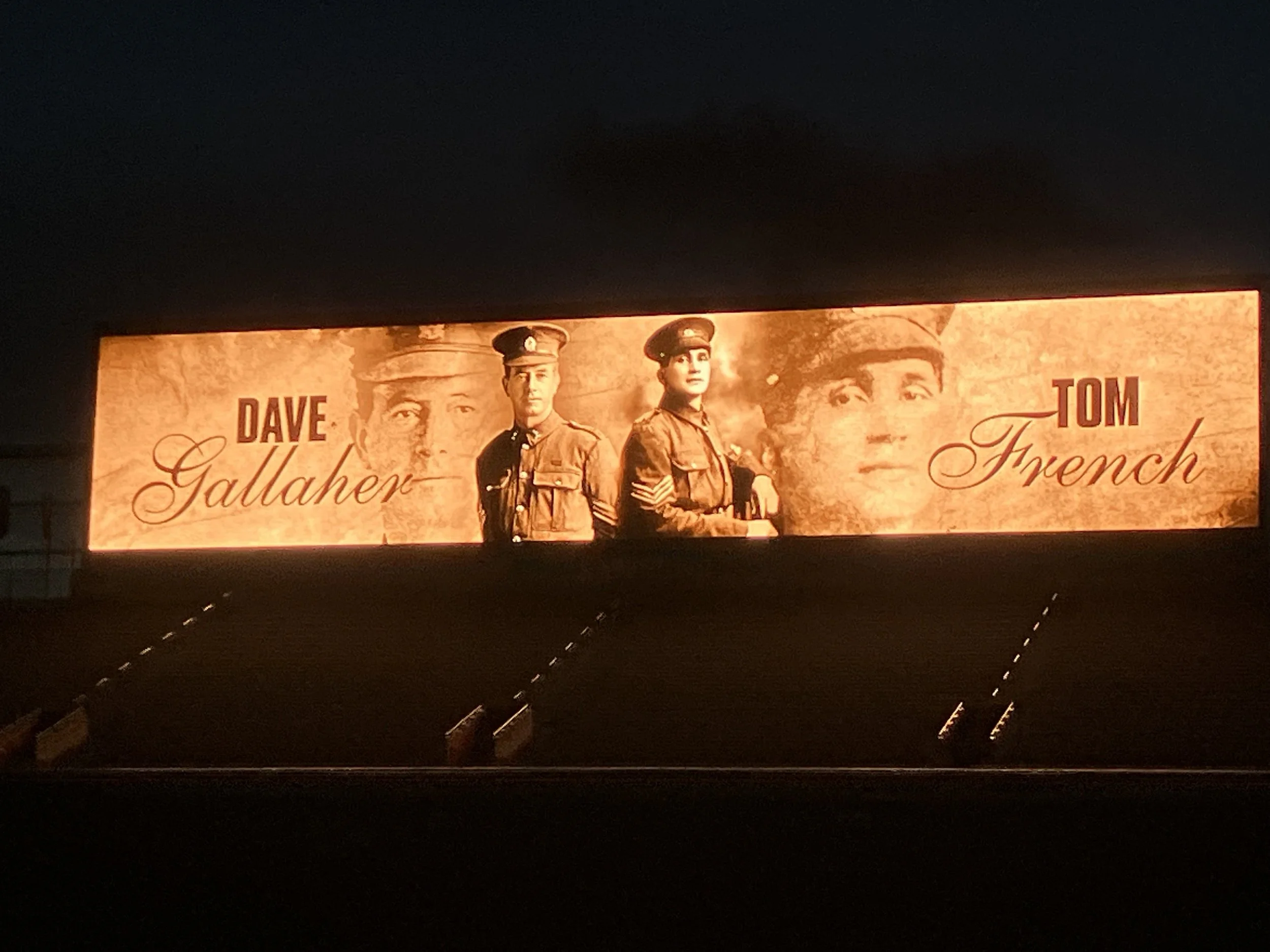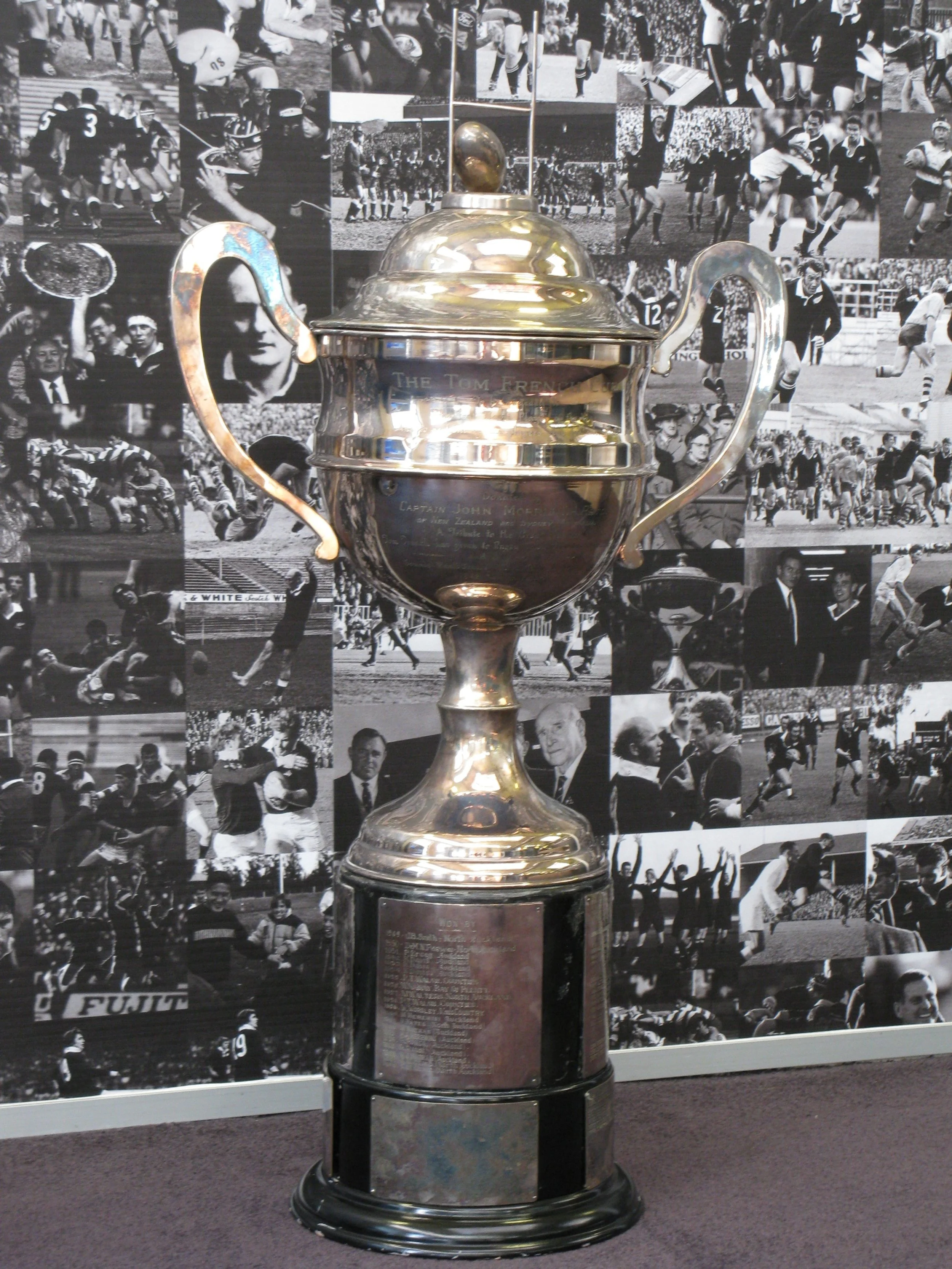
Tom French
History of our Tūpuna
I Introduction
Born beneath a Pohutukawa tree at Waipapa Marae beside the lapping waters of Kāwhia Harbour, his mother a full bloodied Māori woman of Tainui descent and father a Pakeha man born in India. From these humble origins was to emerge a talented Māori athlete. Variously described as the General, the Maestro and lauded as the Pre-war idol of the Auckland crowds, who, under the guidance of Dave Gallaher was on the cusp of All Black honours. World War I (WWI) was to cruelly disrupt Tom's life. The war shattered the peaceful existence he once knew, leaving him significantly disabled. Arriving back in Aotearoa New Zealand after the WWI he set about rehabilitating his life by marrying his pre-war sweetheart, raising a family and immersing himself in all things to do with rugby. He was a dedicated referee, coach, selector, manager a governing member of the Māori All Blacks advisory panel. For decades his existence was interwoven with all facets of Māori rugby. He was remembered by those he coached as a perfectionist, a hard task master, but a man entirely fair to his players. The Tom French Cup, awarded to the best Māori player every year since 1949, a trophy imbued with his legacy a testimony to his passion for all things rugby.
Tom French, always a dapper dresser.
II Origin
Of Māori / Pākehā decent, with whakapapa connections to Waikato, Ngāti Hikairo in Kāwhia. He had no idea of his true date of birth, not the day or month or even the year perhaps due to the isolated coastal nature of Kāwhia in those days. He was most likely born in 1889, (between elder brother Sam and younger sister Bessie), at Waipapa Marae Kāwhia beneath a Pohutukawa tree. His mother Te Anu Pohepohe, of noble lineage, and father John French, a roading engineer, who was born in India.
His mother Te Anu Pohepohe died in 1894 and his father John French was either unable or unwilling to raise the three siblings. He was fortunate to have his aunt Rangi Kano Kano raise the tamariki completely emersed in Māori culture. However, they were unable to speak English and it was thought that integration into a European culture might be beneficial for the children. And so the children were separated and raised by different families. Tom was to grow up on Matakana Island in Tauranga Harbour.
Tom's date of birth on his army enlistment states September 16 1889. Invariably, a date of convenience. Toms' marriage certificate, according to son Tony French, records his birth as 1890.
Young Tom, right. Possibly Tauranga or Taupo teams
Westport rugby team 1912. Tom back row fifth from left.
Brother Sam French 2nd from left.
III Rugby Emergence
Rugby player: Tom spent his adolescence growing up on Matakana Island and ascended into the sporting limelight playing for the Tauranga Star rugby club in the Bay of Plenty region in 1910. Emerging from the Taupo region he was selected as a Māori All Black by Ned Parata in 1911 and again in 1913. The 1913 Māori team had the privilege of touring internationally to Australia. His height and blinding speed distinguishing him from his fellow players. Tom's favoured position was as Wing Forward, but he was often selected for prop as well. He was a Westport, South Island Country team, and Buller Representative in the South Island, during 1912 / 1913, with brother Sam French, who's family he boarded with.
Dave Gallaher former 1905 All Black captain and, in 1914, current Auckland rugby club manager / selector had seen Tom play on several occasions from 1911. Impressed with Tom's athleticism and style of play, Dave suggested Tom leave the provincial south and move to the powerhouse of Auckland rugby. Dave also indicated that All Black honours were not far away. Dave at the time was also an All-Black selector.
As an Auckland representative Tom's club side was "City" in 1914 and for a couple of matches also in 1915. Tom played in all of Auckland's interprovincial matches of 1914 where he earned the plaudit "idol of the crowds". Mentored and coached by Dave Gallaher, he also worked with Dave on Kings wharf for the Auckland Farmers Freezing Company. On arriving in Auckland Tom initially boarded with Dave’s family in Ponsonby. Recreational sailing on weekends, and cricket in the summer, were the norm with Dave and fellow players.
On May 2, 1914, Tom played in his first ever match on Eden Park, a season warm-up match between clubs City and University. Tom was also the first player to be sent off Eden Park. Apparently for punching in the nose of an opposing player who had eyes for the girl Tom was keen on. The crowd booed, Tom thumbed his nose at the crowd and was duly marched off the freshly minted pitch.





IV World War I
Heeding the call to duty Tom enlisted with the Auckland battalion early 1915. He was, however, transferred to Otago battalion in Trentham army camp to make up a personnel shortfall. Whilst in Trentham Camp he trained to be a soldier and was also able to indulge his passion for rugby as a member of the Trentham army rugby team of 1915. Originally assigned Army serial no. 8/2595 (but only temporarily as events came to pass).
He trained at Trentham camp with the Otago's but he was to transfer to Second Māori Contingent mid 1915 for reasons known only to himself, this may have included a certain young lady he had met in Auckland previously while having a uniform altered. The Second Māori Contingent were assembled to commence training at Narrow Neck in Auckland. Tom received a new army serial no. (16/972). The 16 denotes "Māori". 16/972 remained his serial number for duration of World War 1, his war records are stamped on the side of his medals.
The Second Māori Contingent trained at Narrow Neck, Takapuna, Auckland from mid 1915 and departed Aotearoa New Zealand in September 1915 arriving in Egypt October 1915. Prior to Tom's departure for the war, his Aunt Rangi Kano Kano a Tohunga provided karakia for him and his fellow Māori soldiers, a ceremony at Te Puia Springs where the soldiers stood with their backs to the ocean and cast a sprig of Toi Toi behind them. If the sprig washed back between their legs, it was believed they would return safely from the war. There were several incidences where those who did not participate in this ceremony were not to return. This sacred ceremony performed for warriors in ancient times was also observed for departing soldiers during World War II.
Sergent Tom French, Otago Battalion.
Training at Trentham, mid 1915.
V Egypt, France and Belgium
On arriving in Egypt, the Second Contingent were fully expecting to join the first Māori contingent on the Turkish Peninsula of Gallipoli. However, they were to spend months training in the desert and were finally joined by the First Māori Contingent in January 1916 who had been freshly evacuated from Gallipoli. The combined Māori Contingents were reformed into a Pioneer battalion with elements of the Otago mounted rifles. It was the job of the Pioneers to labour preparing, servicing and maintaining the battlefield.
Recreationally Tom played much rugby whilst in the Egyptian desert. The Māori team were runners up in divisional rugby championship. 3/nil against Wellington. Tom had the privilege of captaining the side on several occasions. At an athletics event held in the desert Tom placed second in competition with the N.Z. 440-yard running champion "Darky" Byrne.
In September 1916, five months after arriving in Europe, the Pioneers were driving the famous Turk Lane trench forward towards the German positions on the Somme. It was also in September of 1916 that Tom elected to transfer, to 1st Auckland Battalion 3rd company. Again, reasons are not clear, but maybe Tom just wanted to be at the sharp end of the fight. Historian Chris Pugsley postulated that it might be because of rugby. The creation of a divisional rugby team was fermenting and a transfer to a new battalion may have been advantageous for Tom's selection. Either way Tom's transfer took effect on September 25, 1916 amidst the N.Z. action on the Somme in the vicinity of the town of Fler. As a member of the First Auckland Battalion Tom was wounded two days later on 27 September 1916. This was to be the first of two wounds sustained during battle. Seemingly a minor wound, Tom was off the frontline for several weeks recovering.
Brother Sam French 16/1480 died at sea of meningitis, during August, whilst in transit to England in 1916 with the 5th Māori Contingent. Sadly Tom learnt of his brother’s death when the Contingent docked in England.
1916 /17 New Zealand Army representative team, The Trench Blacks.
Tom, back row 5th right (looking sideways)
VI The Trench Blacks
Tom was a member of the 1916 and 1917 New Zealand Expeditionary Forces Rugby team.............. The Trench Blacks. The finest assemblage of New Zealand rugby talent at that time, not yet shot dead. All Blacks, Māori All blacks and top representative players from throughout the country. Two photographs show him in both Trench Black teams 1916 and 1917. Playing for this team was to be the height of Tom's rugby achievements. Members of the team trained as instructors in military craft while honing their abilities on the field as a cohesive rugby playing unit.
There was a famous match which the Trench Blacks won 40 - 0 against the French side, many of whom had been plucked from the front lines literally the day before. Witnessed by the largest crowd ever assembled to view a rugby match, reputedly 60,000 spectators, the event took place at Parc Jaques Anquetil, a Velodrome, at La Cipale Paris on April 8, 1917. A statuette named the Somme Cup was awarded to the victorious Trench Black side. The cup was crafted by renowned French sculptor Georges Chauvel whilst in the trenches. The match was also a celebration to mark the recently announced American decision to join the war against Germany. High-ranking military officials, politicians and American diplomatic staff witnessed the occasion. The stadium still exists in Paris today in pristine condition.
French motion picture footage captures Tom and this team playing the French side. This footage is available on the French ECPAD film history site. Tom is fifth from right back row wearing the number 15 jersey.
Somme Cup
Tom French Cup
VII Passchendaele
Wounded twice while in France and Belgium. Firstly, in September 1916 (France) during the Battle of Somme . He then went on to fight at Messine Belgium in June 1917, a highly succesful battle. However, four months later Tom was grievously wounded during the first New Zealand Passchendaele engagement of October 4, 1917. Tom was also exposed to German gas at some point of his tenure in France or Belgium resulting in emphysema during later life contributing to his death in 1970.
His second wounding was severe and happened during the first action of two, the New Zealanders were to take part in during the Passchendaele campaign of July to November 1917. On 4 October, near Broodseinde in Belgium, after an earth-shattering artillery barrage. Tom and fellow soldiers, as part of the first wave of the Auckland battalion, attacked the German line at dawn. Tom was wounded by either a shrapnel injury or shot in the left arm while capturing Passchendaele ridge. Tom bandaged his wound and stumbled about for hours in a state verging on hypothermic, across a miserably wet and cold battlefield. He walked many kilometres before finally reaching the regimental aid post at Weitje behind the front line. Transferred to a military hospital in France Tom’s arm was partially amputated at the elbow due to complications from gangrene. This was followed by a subsequent full amputation, in England, resulting in the loss of an entire left arm from the shoulder.
Four Amputees
From a postcard, written on the back was "Four Limbless Lads, some picture".
Tom and 3 fellow amputees recovering at Oatlands rehabilitation hospital. 1917/18
VII Passchendaele Continued
The entire Auckland battalion were badly mauled on 4 October . Almost 500 New Zealanders dead, 1100 wounded. However, the battle of Broodseinde was considered a significant victory. The New Zealanders captured enemy territory and drove the front line forward 1600 metres which was viewed as a momentous step towards the ambition of capturing the village of Passchendaele. His dear friend, coach, mentor and work colleague Dave Gallaher died of wounds this day in a field hospital near Poperinge. Tom and Dave had spoken just days before.
A more detailed account about Tom’s experience on the 4th of October is described in the diary of Frank Athol Gillman, one of Tom's fellow soldiers, and is included in the long-form biography below.
The cost of the action that day at Broodseinde, paled in comparison to the carnage of the battle of Belvue Spur eight days later on October 12, 1917. Where 847 New Zealanders died, 2700 were wounded in just four hours. Over the following weeks and months and years the death toll would rise significantly by many hundreds. New Zealanders simply refer to this battle as "Passchendaele" a battle that reverberates through history.







VIII Recuperation and return home
Tom spent an incredibly long time in recuperating in England at Walton on Thames hospital and then in rehabilitation at nearby outpost Oatlands hospital where the Limbies were treated. His wound was very slow to heal. His duration of recovery took from October 1917 to January 1919. This extended recovery period spent in the company of other severely disabled patients probably helped Tom come to terms with his circumstances. The Oatlands facility exists to this day, now a hotel.
While rehabilitating in England. Tom started training in Agriculture (See photograph of him toiling a field wearing his uniform).
Returning to New Zealand on board the New Zealand hospital ship Zealandic which disembarked at Wellington on February 28 1919. Discharged from Army May 1919, whilst still receiving treatment for his wound. Four years and 16 days total in armed service.
Summer 1918. Rehabilitation Farm, Torquay.
Rehabilitation with fellow soldiers and friends.
Tom married his pre-war sweetheart Hannah Courtney in 1920, she was the seamstress he met getting his uniform altered many years before. Tom took advantage of further training in agriculture, sponsored by the Government, at Ruakura near Hamilton. Tom and Hannah were to raise four children, two girls and two boys. (Patricia, Margaret, Tom and Tony).
Tom immersed himself in all forms of rugby while in agricultural training during 1919/1920. His reintegration into the normality of society and peace was facilitated by becoming a rugby referee. Coaching, managing selecting and general administration followed. Tom was an inaugural member of the Māori Rugby Advisory Board 1922, (everything pertaining to Māori rugby). This was to become a lifelong devotion. His total contribution to all things rugby over the ensuing years was immense.
In 1921 he transferred to Wairoa and became a noxious weeds inspector. His career as rugby coach, selector, manager burgeoned. He trained many famous All Blacks who joined the 1924 Invincible All Black team such as George Nepia, Brownlee brothers, Sam Gemmel et al. The 1924 side toured the U.K and remained undefeated.
Hannah French passed away in January 1944 in Rotorua. A devastated Tom and family returned to Auckland. Tom reprises his association with Auckland rugby as a coach, selector, manager and general administrator.

IX Tom French Cup
Tom coached and managed the famous 1949 Māori rugby team to tour Australia. A consolation tour granted to Māori players who were unable to join the All-Black team to South Africa because of the regimes stringent apartheid policy. The 1949 tour of Australia was so successful and held in such high regard the Tom French Cup was struck and is still bestowed to the best Māori player every year to this very day. Australian Captain John Morris (military) who instigated the cup, described Tom as the Genius and Maestro after witnessing the Māori play throughout Australia.
In 1956 the Māori All Blacks were to endure a fractious encounter with the South African Springbok side which was preceded with pre-match political interference from the highest political levels. The New Zealand Government Minister of Sport feared interracial conflict and ordered the Maori side to refrain from any aggressive or contentious activity. The psychological effect, of this instruction, was to severely impact on a side renowned for their enthusiasm and zeal leading to a comprehensive defeat.
1949 Māori All Black tour of Australia
1949 Māori All Black tour of Australia
Referee Tom
Tom was also instrumental in attempting to form an all Māori Auckland team "Aotea". This side slowly atrophied due to lack of interest and support from the upper rugby echelon. In 1957 Tom French was made life member of New Zealand rugby Union recognising his contribution to so many teams and particularly Māori rugby. Son Tom J French was an Auckland representative and Māori All Black during 1940's and 1950's.
Tom retired from Rugby in 1962 after more than 50 years devotion to rugby. (1910 first reference to Tom playing rugby for Star in Tauranga. 1911 first A recorded exploits as Māori All Black ).

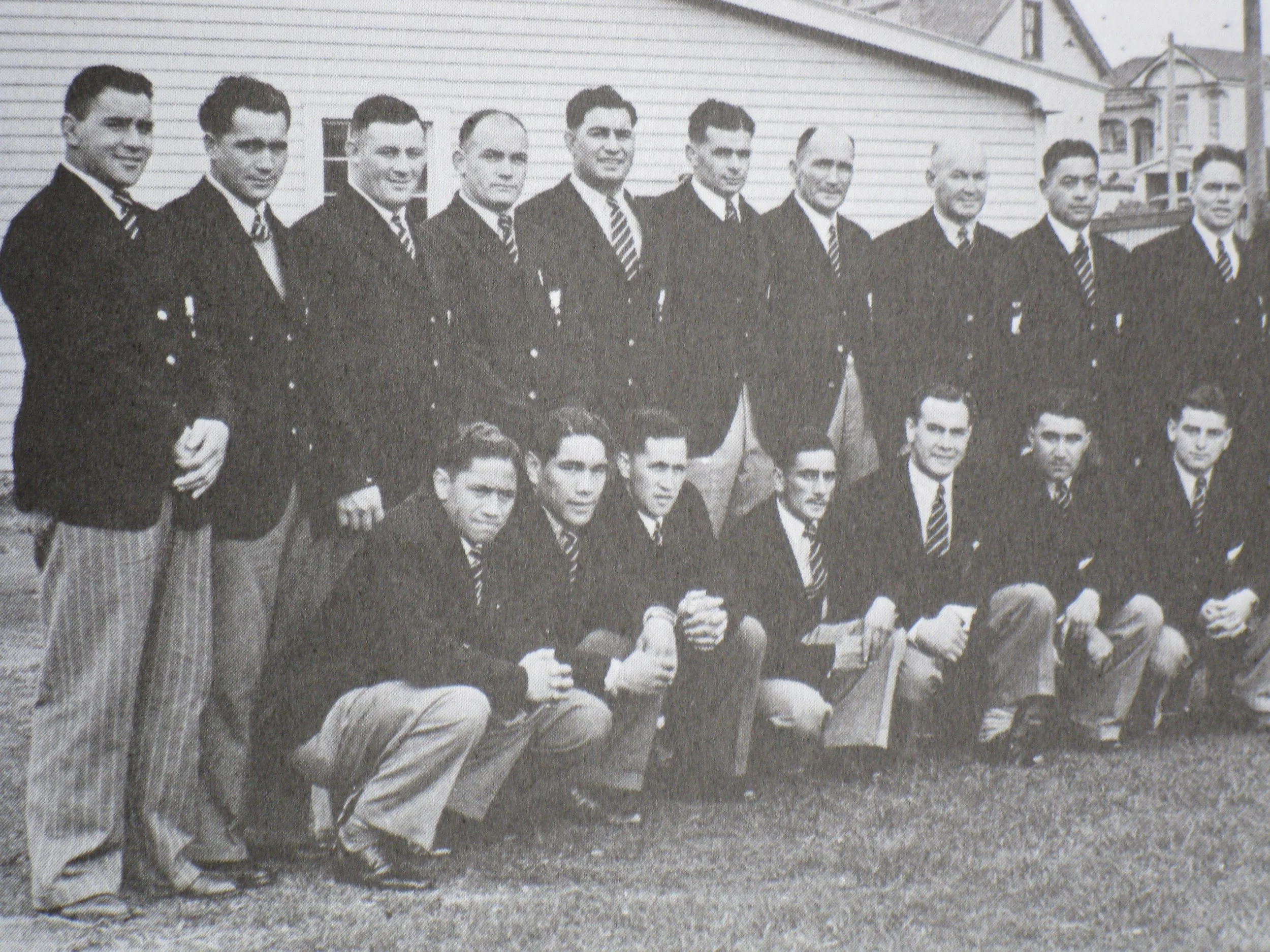

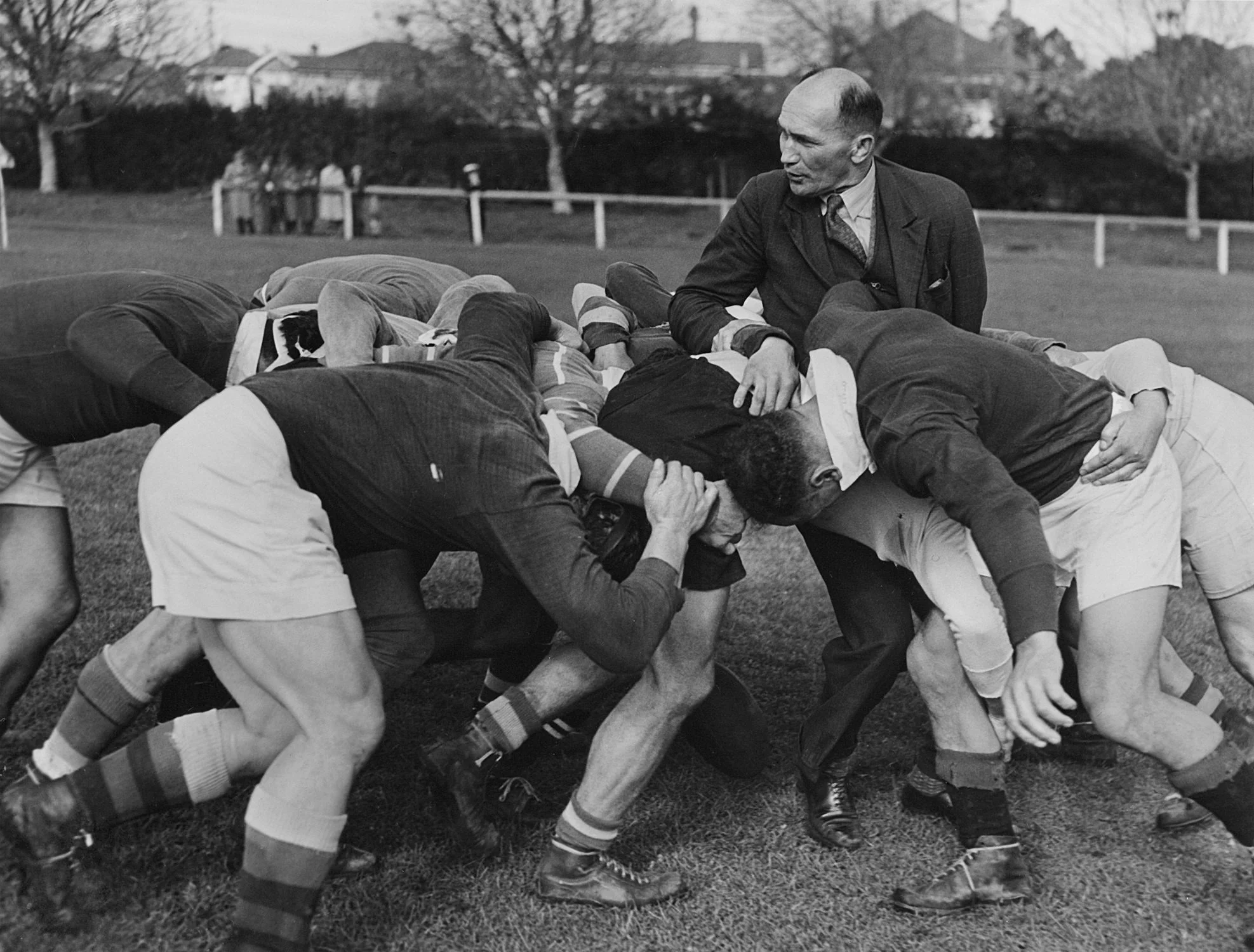


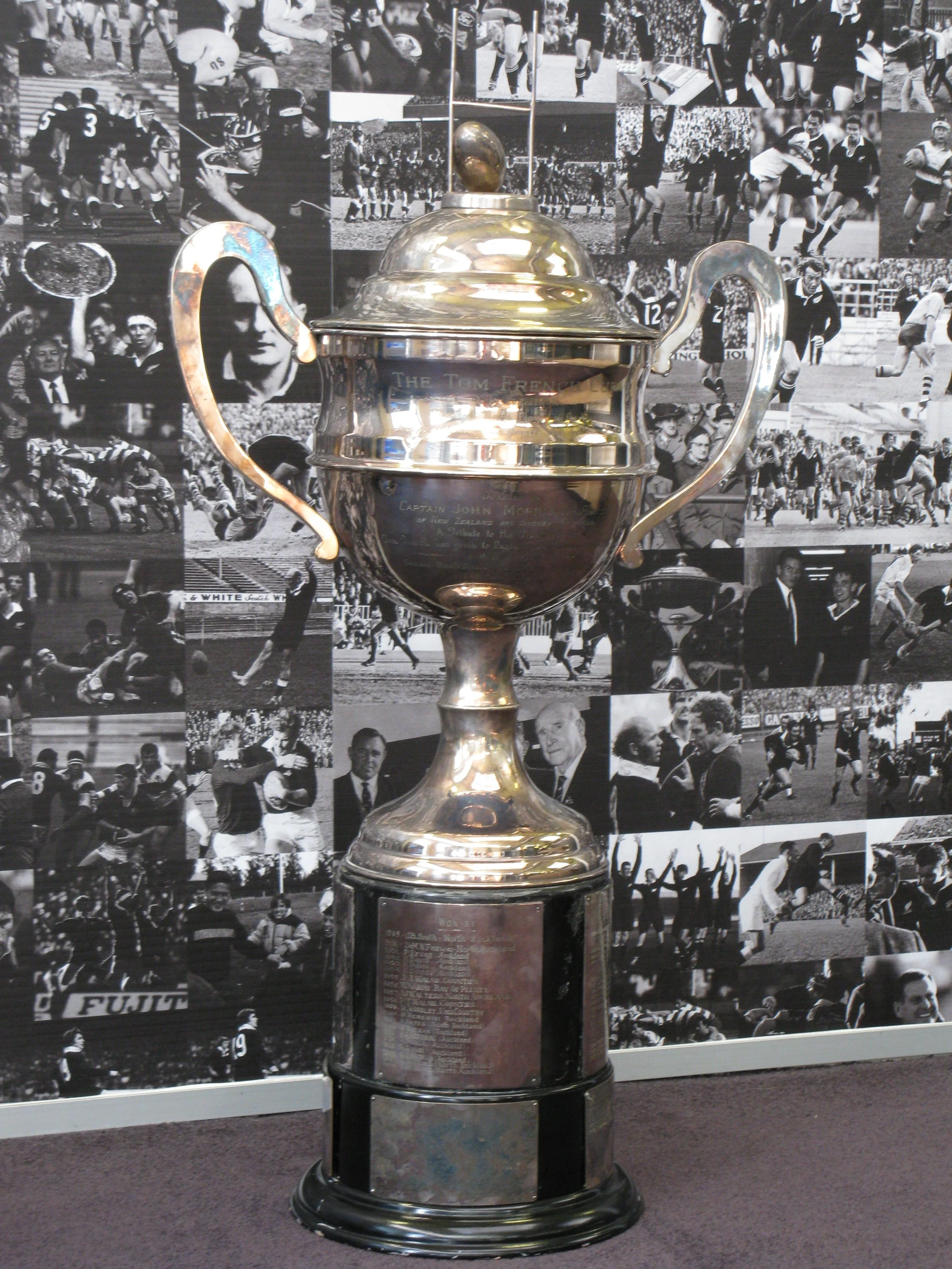

X Kāwhia Ties
Tom never lost contact with Kāwhia and his roots frequently returning for Pokai, events and Tangi. Following retirement in the 1950's, from the position of Chief Port Inspector for the Ministry of Agriculture in Auckland, Tom returned full time to farm at Ōpārau Kāwhia. In 1962 and he married for the second time to Daphne Williams, a Flight Sergeant in the Airforce. One son possibly last, and youngest from a first war veteran. Tom was approximately 74ish at the time.
During 1960's Tom continued with an interest in fostering a Māori Education Fund which he helped establish travelling the length of New Zealand raising funds with his good friend Doc Paiwai.
Concerned by erosion of sand dunes along the coast and the subsequent encroachment of sand blown inland threatening the long-term viability of Kāwhia township, and also accompanied with concerns about employment prospects in the district, Tom was part of the committee instrumental in forging into existence the Tainui Kāwhia Incorporation. This was a joint venture partnered with the New Zealand Government. TKI in the late 1960's planted Marram grass to firstly stabilise the dunes before the first Pine trees were planted in August 1970 at a ceremony attended by his wife and sons Tony and Karl. Tony planted a tree on Tom's behalf. At the time this approach was a little experimental, however, it has been shown to be extremely effective. The project halted erosion and had it's first harvest in the mid 1990's. With the proceeds, the Governments share of the enterprise was bought out. Now solely owned by TKI, the operation continues on generating revenue and employment for the folk of Kāwhia. Harvesting of the forest for the second time began in 2024. The committee remembered Tom's contribution to TKI by naming the access way to Ocean Beach and Te Puia hot springs “Tom French Grove” in remembrance of Tom and fellow Māori soldiers spiritual link with Te Puia Springs where they had undergone a blessing ceremony prior to departure to both world wars.
Tom and Karl, Ōpārau, 1968.
Tom took a keen interest in the goings on in and around Kāwhia. He helmed the committee to replace the old dilapidated wharf. Tom was extremely proud to attend the opening ceremony of a brand new state of the art wharf which also had facility to store and chill fresh catch. This greatly assisted the Kāwhia fishing industry which was particularly strong and vibrant in the 1960's. Next the committees' attention was focussed on the development of a new hall. This project was successfully funded and built to cost. The opening of the new hall was a big event for Kāwhia and Tom and family were in attendance that day.
1968 and 1969 saw Tom in Court battling the Māori Affairs Department. Promises had been made, for decades, to assist Māori farmers in the district financially with the development of their farms. Government money was, and had been, available for this purpose for some years. Using parts of his farm at Ōpārau as an example Tom won his case in the Hamilton Court. Māori farmers around the Kāwhia district were to benefit from this action.
As Tom was subject to a degree of racism his entire life, and he was very vocal about lack of inclusion of Māori players in tours to South Africa. He appeared on the newly commissioned Television network, radio and print media during the early 1960's advocating for Māori inclusion in future tours to South Africa. His voice and opinion always keenly sort after.
Tom and Karl, Ōpārau, 1968.
Tom and Karl, Kāwhia, 67/68.
Tom and Karl, Kāwhia, 67/68.
Tom French retires to Manurewa Auckland in December 1968. Dies 1970 of emphysema as a result of gas exposure during W.W1. Aged approximately 80 / 81.

XI Tribute
On September 29 2025, a commemorative ceremony was held at Eden Park to honour Dave Gallaher and Tom French. The event was officiated by Sir Jerry Mateparae, who conducted a turf-cutting ceremony as part of the proceedings. During the ceremony three sizable portions of playing turf were carefully cut from the field and placed into boxes for transportation to significant locations associated with Dave Gallaher in Europe.
The three destinations for the turf are:
Ramelton, Ireland — Dave Gallaher's birthplace.
Parc des Princes, Paris — where he played rugby.
Nine Elms Cemetery — where he is buried.
Additionally, the ceremony acknowledged Tom's connection with Dave Gallaher and Eden Park both as a player and administrator. Photographs of Tom and Dave were displayed on the scoreboard throughout the ceremony in tribute to their enduring association with rugby, WW1 and Eden Park.
Eden Park, September 29th, 2025.
Eden Park, September 29th, 2025.
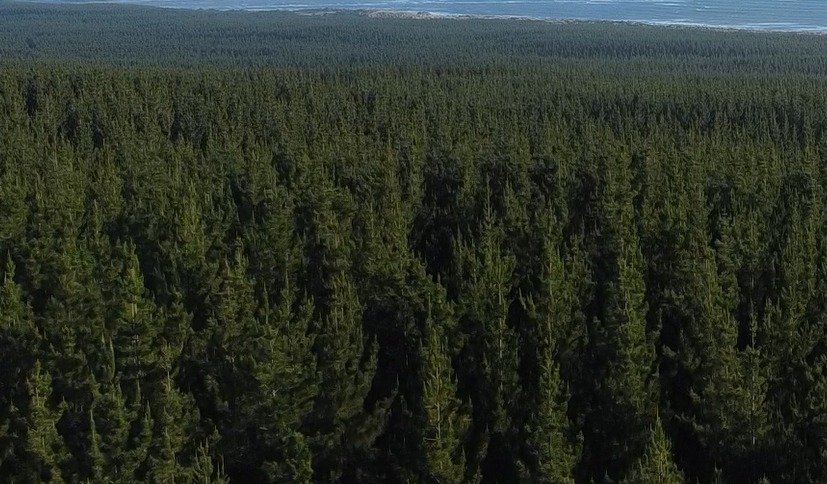
XII Summary
Please understand this short summary is to assist the reader with the bare facts associated with the longer in-depth Tom French profile. To fully appreciate Toms' life and the contribution he made to New Zealand both the long biography and separate sporting profile should be consulted. The numerous quotations from Papers past are an outstanding testimony to his life and prowess as one of New Zealand's great sportsmen. I've always believed Tom's story would be the genesis of a great movie.
Full length, detailed, biography linked here.
Other resources French ECPAD film library / Diary of Frank Athol Gillman located in Alexander Turnbull library Wellington.
Karl French.
Māori All Black
Formal touring dress
1913















